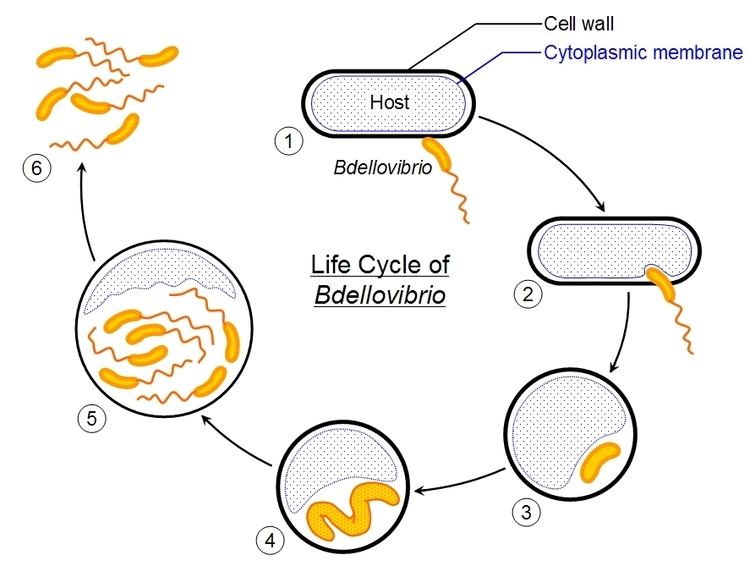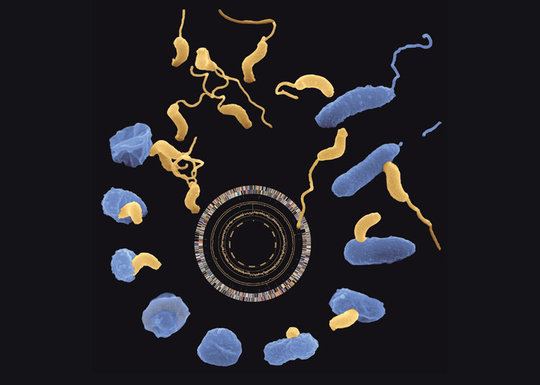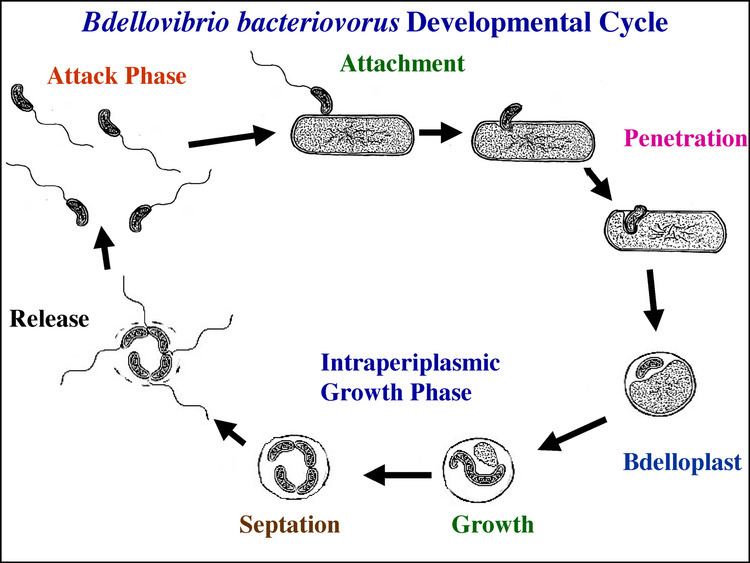Species B. bacteriovorus Rank Genus Phylum Proteobacteria | Family Bdellovibrionaceae Scientific name Bdellovibrio Higher classification Bdellovibrionaceae Order Bdellovibrionales | |
 | ||
Similar Bacteria, Proteobacteria, Deltaproteobacteria, Myxobacteria, Micavibrio aeruginosavorus | ||
Bdellovibrio attacking e coli bacteria
Bdellovibrio is a genus of Gram-negative, obligate aerobic bacteria. One of the more notable characteristics of this genus is that members parasitize other Gram-negative bacteria by entering into their periplasmic space and feeding on the biopolymers, e.g. proteins and nucleic acids, of their hosts. After entering the periplasmic space of its host the Bdellovibrio bacterium forms a structure called a bdelloplast which modifies both predator's and prey's cells. The predator cell can remain dormant at this stage, without affecting the viability of the host. In most cases, though, Bdellovibrio devours its prey and moves on. Because of this, Bdellovibrio can be considered bacterial predators, in addition to parasites. Bdellovibrio bacteriovorus was first described by Stolp and Petzold in 1962. Two other species, Bdellovibrio starrii and Bdellovibrio stolpii, have been moved to a separate genus Bacteriovorax.
Contents
- Bdellovibrio attacking e coli bacteria
- Bacterial predators bdellovibrio
- Appearance
- Culture conditions
- Life cycle and parasitism
- Genomics
- References

Bacterial predators bdellovibrio
Appearance
Under the microscope, a Bdellovibrio appears to be a comma-shaped motile rod that is about 0.3–0.5 by 0.5–1.4 µm in size with a barely discernible flagellum. Colonies of Bdellovibrio show up as a growing clear plaque in an E. coli lawn.
Another notable feature of Bdellovibrio is the sheath that covers its flagellum. This is a rare characteristic among bacteria. Flagellar motility stops after Bdellovibrio penetrates its prey. In some cases the flagella is shed; in others it protrudes from the outer membrane of the prey cell.
Culture conditions

Bdellovibrio species are found in river water or soil and live an intraperiplasmic existence. Bdellovibrio is grown in the laboratory with nutrient broth diluted 1:500 (also known as NB/500) and mixed with hot soft agar. Cultures are grown with a population of E. coli at 30 °C for one week. Bdellovibrio may also be cultured using YPSC(yeast extract, peptone, sodium acetate, calcium chloride) overlays or prey lysates.
Life cycle and parasitism

Bdellovibrio cells can swim as fast as 160 µm/s, or over 100 times their length per second. It swims using a single sheathed polar flagellum with a characteristic dampened filament waveform. Bdellovibrio attacks other Gram-negative bacteria by attaching itself to the prey cell's outer membrane and peptidoglycan layer, after which it creates a small hole in the outer membrane. The Bdellovibrio cell then enters the host periplasmic space. It remains reversibly attached to it for a short "recognition" period. After the recognition period, it becomes irreversibly attached via the pole opposite the flagellum. Once inside the periplasm, the Bdellovibrio cell seals the membrane hole and converts the host cell to a spheroblast. A mixture of hydrolytic enzymes is applied in a locally targeted manner that prevents excessive damage to the prey and counters diffusion. This two-cell complex is now called a bdelloplast. The Bdellovibrio cell uses hydrolytic enzymes to break down the host cell molecules, which it uses to elongate and form a filament. When the host cell nutrients are exhausted, the filament septates to form progeny Bdellovibrios. The progeny become motile before they lyse the host cell and are released into the environment. The entire life cycle takes from one to three hours, and produces an average of 3–6 progeny cells from a single E. coli, or up to 90 from larger prey such as filamentous E. coli.
Targets of Bdellovibrio species, including Vibrio vulnificus, may undergo coinfection by Bdellovibrio and bacteriophage.
Genomics

The genome of Bdellovibrio bacteriovorus HD100 was sequenced in 2006. The HD100 genome is 3782950 nucleotides long, larger than expected given its small size.
